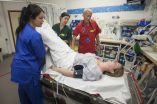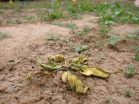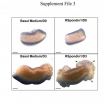(Press-News.org) A research team at Linköping University, together with colleagues in Europe and the United States, has shown that at extremely high pressure even the innermost electrons in the atomic nuclei of the metal osmium begin to interact with each other, a phenomenon never witnessed before. The findings have been published in Nature.
"If we know more about how a matter works, we will be in a better position to develop materials that withstand extreme conditions. In research we're constantly making advances, but in this case we've taken a giant leap", says Igor Abrikosov, professor of theoretical physics at Linköping University, who also leads the theoretical team within the project.
We already know that material properties change at high pressure. As pressure increases, the distance between the atoms decreases, and the outer electrons, the highly mobile valence electrons, interact with each other. It is also the valence electrons that determine the material's properties. For example under high pressure a shiny electrically conductive metal such as sodium becomes a transparent insulator, and a gas such as oxygen solidifies and conducts electricity. The oxygen can even become superconductive.
But while the valence electrons are highly mobile, the inner electrons continue to move steadily around their atomic nuclei.
The highest pressure achieved thus far is 4 million atmospheres or 400 GPa, which is roughly the pressure at the earth's centre. But thanks to a newly developed method, the researchers have been able to achieve a pressure that is twice as high as at the earth's centre and 7.7 million times higher than at the earth's surface. With great precision they have then been able to measure both temperature and relative positions of atoms in a small crystalline piece of osmium. Osmium is the metal with the highest density and is almost as incompressible as diamond.
Compressing osmium to this high pressure, the researchers found an unexpected anomaly in the relationship between the interatomic distances.
"The high pressure didn't result in any significant change to the valence electrons, which surprised us. It made us rethink things, and go back to the theories", explains Prof. Abrikosov.
Advanced supercomputer calculations at the National Supercomputer Centre, NSC, in Linköping later revealed how the innermost electrons start to interact with each other as a result of the extreme pressure.
"This is a perfect example of collaboration between experimental and theoretical materials research", says LiU researcher Dr Marcus Ekholm, co-author of the article.
This breakthrough is the result of a long-standing collaboration between the research team at LiU and researchers in Germany, the United States, the Netherlands, France and Russia. The researchers at Bayreuth University in Germany developed the method that makes it possible to apply twice the pressure that was previously possible, while still being able to measure and maintain control. This high pressure could exist at the centre of larger planets than ours.
"Interaction between inner electrons has not previously been observed, and the phenomenon means that we can start searching for brand new states of matter", says Prof Abrikosov.
The results have been published in the highly ranked journal Nature.
"We're really delighted, and it's exciting as it opens up a whole box of new questions for future research", says Prof Abrikosov.
INFORMATION:
The Most Incompressible Metal Osmium at Static Pressures above 750 GPa,
L. Dubrovinsky, N. Dubrovinskaia, E. Bykova, M. Bykov, V. Prakapenka, C. Prescher, K. Glazyrin, H.-P. Liermann, M. Hanfland, M. Ekholm, Q. Feng L. V. Pourovskii, M. I. Katsnelson, J. M. Wills, and I. A. Abrikosov.
Advance Online Publication on Nature´s website from 24 August 2015.
Doi 10.1038/nature14681
Contact:
Professor Igor Abrikosov, tel. +46 709 295 650. Out of office, but can be reached 25 August, 10.45 - 11.05, 12.50 - 14.00 or after 15.45, CET.
Email: igor.abrikosov@liu.se
The method:
Diamond anvil cell
This method has been in use since the late 1950s. The researchers in Bayreuth, with the help of nanotechnology, have developed a small synthetic diamond that is positioned halfway between two ordinary diamonds, on each side of the Osmium crystal. The small diamonds are just a few thousandths of a centimetre in diameter. Because the area is significantly decreased, the pressure is significantly higher.
A new £6.65 million grant for research aimed at accelerating the discovery and application of new advanced materials for the energy sector was announced today by the Engineering and Physical Sciences Research Council (EPSRC).
The grant, awarded to a team led by Professor Matthew Rosseinsky of the University of Liverpool, will support a programme, Integration of Computation and Experiment for Accelerated Materials Discovery.
Professor Rosseinsky will head up an expert team at Liverpool and University College London that will work to tackle the challenge of designing ...
Noroviruses are the predominant cause of gastroenteritis outbreaks in community settings such as hospitals, cruise ships, and schools. The virus is extremely contagious and is mostly transmitted via "fecal-oral-route", i.e., through contaminated hands or contaminated food. Symptoms include violent and sudden onset of diarrhea, vomiting, and nausea.
"It is therefore important to provide a safe and harmless disinfectant against human norovirus," explains Grant Hansman, head of CHS junior research group at the German Cancer Research Center noroviruses and the University ...
A simple, safe and cost-free modification to a physical technique used to treat patients in the emergency department with an abnormally fast heart rhythm could improve its effectiveness by more than a quarter, according to a study published in The Lancet today (25 August 2015).
An abnormally fast heart rhythm, also called supraventricular tachycardia, can be distressing for patients and many come to emergency departments for treatment. Symptoms can include chest pain, light-headedness, dizziness and breathlessness. Episodes can last from a few seconds or, in extreme cases, ...
This news release is available in German. Trillions of bacteria populate the human gut - which makes them more common than any other cells in our body. The composition of this bacterial population is very variable and influenced by our diet. Diseases, but also antibiotic treatments can induce significant shifts in this equilibrium. If entire bacterial groups suddenly multiply heavily, critical situations occur. They damage the intestinal tissue and cause inflammations. How such shifts are triggered largely remained a mystery. Physiologists from the University of Zurich ...
This news release is available in German.
Root bacteria are known to form symbiotic relationships with plants by improving the plants' supply of nutrients. Yet as scientists at the Max Planck Institute for Chemical Ecology in Jena, Germany, found recently, the bacteria actually play a much more profound role. During field experiments in Utah, in the western USA, researchers discovered that the right mixture of soil microbiota directly influences the survival of Nicotiana attenuata, a species of wild tobacco. Plants that had been unable to establish a protective ...
University of Manchester scientists have bridged a gap between two separate pieces of small intestine kept alive outside the body, in an advance which could have implications for surgery in human adults and babies.
It is not currently possible to study the intestine in embryos when inside the body, which holds back advances in treatment for conditions causing damage in infants. However, new techniques used by the researchers in this study have allowed organs to be kept alive and grown on supports which allow the absorption of nutrients.
A video is available here
or ...
In an era where popular culture is increasingly recognized for its impact on lay understanding of health and medicine, few scholars have looked at television's powerful role in the creation of patient expectations, especially regarding pregnancy and birth.
As part of a larger research project funded by a National Science Foundation Dissertation Improvement Grant, Danielle Bessett, University of Cincinnati assistant professor of sociology in the McMicken College of Arts and Sciences examined how women understand their television viewing practices regarding pregnancy and ...
A team of researchers at the U.S. Department of Energy (DOE)'s Lawrence Berkeley National Laboratory (Berkeley Lab) developing a bioinorganic hybrid approach to artificial photosynthesis have achieved another milestone. Having generated quite a buzz with their hybrid system of semiconducting nanowires and bacteria that used electrons to synthesize carbon dioxide into acetate, the team has now developed a hybrid system that produces renewable molecular hydrogen and uses it to synthesize carbon dioxide into methane, the primary constituent of natural gas.
"This study represents ...
Waterford, Ireland, August 24, 2015 - Ongoing European Research Council-funded research at Waterford Institute of Technology's (WIT) Macular Pigment Research Group (MPRG) is investigating the potential link between cognitive function and levels of a vital eye pigment linked to diet. The study suggests that measuring macular pigment offers potential as a biomarker of cognitive health. The results of this study are highlighted to a global audience through the prestigious international medical journal, the Journal of Alzheimer's Disease.
The Waterford clinical trial research, ...
Tahiti is a popular tourist destination, but one unwanted visitor has decided to make its home there: the brown widow spider (Latrodectus geometricus). A paper published in the Journal of Medical Entomology has reported the discovery of the spider for the first time on Tahiti and also on four of the Cook Islands.
The brown widow is a known invasive species. It has been found in South America, Central America, North America, the Caribbean islands, and a host of Pacific islands. It was first found in French Polynesia in 2006, when it was discovered on the island of Moorea. ...



